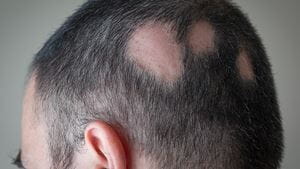
People living with alopecia may feel like they are alone in living with their skin condition, but it is more common than people might think.
Worldwide, about 160 million people have some form of alopecia and lose their hair – either in patches, on their head, or all over their body.
Alopecia areata is an autoimmune disease; it is not contagious. This means people with alopecia have immune systems that mistake healthy hair follicles for dangerous cells and attack them.
Hair loss looks different for everyone who has alopecia. Some people might lose small patches of hair in different areas, including:
Other signs of alopecia might include:
There are several types of alopecia, but 3 main forms of the condition. Alopecia areata is for people who have patchy hair loss. These patches are usual round or oval shaped, and might eventually spread to a more complete hair loss. Alopecia areata totalis is the loss of all hair on the scalp. Alopecia areata universalis results in the loss of all hair on the head, face, and body.
Alopecia affects people of all ages, genders, and racial and ethnic groups, although some people are slightly more likely to start experiencing hair loss than others. Both children and adults can have alopecia areata.
Research shows women experience alopecia areata more than men, and certain people of color live with alopecia more than white people – specifically Asian American, African American, and Hispanic individuals. According to the National Alopecia Areata Foundation, more than 80 percent of people affected by alopecia start to show signs of hair loss by age 40. Roughly 40 percent start losing hair by age 20.
While the exact cause(s) remain unknown, scientists believe multiple genetic factors are at work. People with a family history of alopecia or have other autoimmune conditions have a slightly higher chance of developing the condition. It remains unclear what causes the hair loss to start.
A visit to a dermatologist will help to determine whether any hair loss is alopecia areata. During an appointment, a dermatologist will ask about the patient’s family history and personal health history, and examine some of their hairs. A biopsy or blood test may be done if deemed necessary.
“Based on how much hair a person has lost and how long the hair loss has been going on, there are different treatment options available,” said Beth Lertzman, MD, a dermatologist with Rochester Regional Health. “Adults and children will have different options, as well.”
There are some topical treatments available, such as corticosteroids, anthralin, or minoxidil. These options can help regrow hair for some patients with mild to moderate alopecia.
Patients with more severe alopecia might be prescribed methods that are more concentrated. Contact immunotherapy is a form of treatment that aims to stop the body’s immune system from attacking healthy hair follicles. A provider will apply a chemical to areas of skin affected by hair loss during a weekly in-office visit. There are also oral medications called JAK inhibitors that lessen the response of the body’s immune system, which allows hair to regrow for some patients.
Dermatologists will also help patients explore cosmetic options such as:
“We have a variety of options to help anyone who comes to us about alopecia treatment,” Dr. Lertzman said. “No matter your age or what stage of hair loss you are in, we are ready to help you live the life you want to live.”
